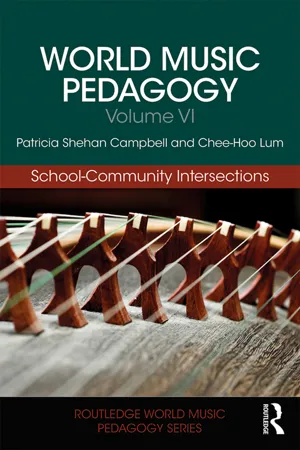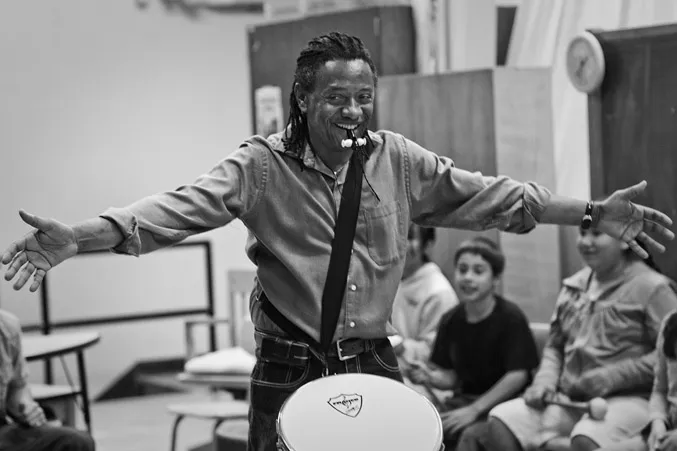A successful partnership of school music educators with community musicians, audiences, and “arts agents” in support of school-community connections rests in an understanding of the interfaces of music with community (and schools). A critical launch-point to the discussion is in selecting out the various meanings of familiar terms, “music” and “community”, since they are so variously used and so frequently favored in everyday conversation and clarifying their particular meanings to the enterprise we are undertaking here. Certainly critical, too, is an awareness of the diversity that exists both culturally and musically in communities (and across school populations) and a recognition of diversity as it relates to music, community, and conviviality. By conceptualizing these terms, the frame will thus be set for a consideration of pedagogical avenues that facilitate learning pathways for students to experience intricate and increasingly evolved encounters with music and culture.
Music
Music is in the ear of the beholder. It exists as an art form, as a force of socialization, and as an expression of cultural identity. It consists of sounds and silences, of elemental features such as pitch (and melody), duration (and rhythm), timbre, texture, and various expressive features such as dynamics and articulation. Not always do musicians care to include all features in their performance, such as the case of rhythmic percussion music produced by a group of Haitian musicians playing same-size hollowed-out bamboo stamping tubes (gangos), where pitch pales in comparison to the rhythmic complexities of the music. On the other hand, performances may go beyond the musical sound in order to encompass also dance, drama, the visual arts, poetry, and more—at times together in a kind of all-encompassing pageantry whose multisensory experiences are nonetheless referred to merely as “music”. In many sub-Saharan African cultures, ngoma is the term applied to music as sound-plus, that is, sound that is typically blended with any number of artistic practices.
One person’s music may be another person’s noise, and there is no guarantee that any two people—particularly from different places in the world—will define music, or identify with music, in precisely the same way. To be sure, carefully designed learning encounters do well to make sense out of what might seem initially to a student like sonic chaos so that the logical structures of music rise to the surface through repeated listening. Likewise, student understandings of unfamiliar music do also develop through a realization of people’s uses and values of it and its historical and contemporary roles in cultural life. There is a wide spread of musical possibilities and preferences, of course, which makes the selection of music for casual use or formal learning a challenge in itself. The question arises: “Do I listen, perform, teach, and compose in the style of Beethoven or Beyoncé, Haydn or hardcore punk, Copland or conjunto, Mozart or maqam? Or all of these and more?”
Music that has been historically prescribed for use in various educational settings frequently excludes the music of many musicians living in local communities, and many more musical expressions found elsewhere in the world may not be found in classrooms. School music teachers have canonized what music is taught and not taught to children and youth, and it’s possible that they have learned what’s appropriate through their university training as well as from finely experienced master teachers in schools who, intentionally or not, continue to perpetuate the music of their own training without reaching out to the wider world of musical possibilities. Inroads have been made, of course, with exemplar musicians and teachers leading the way in opening ears to a broad musical range. Still, it is astonishing that in this time of demographic diversity and tremendous technological access, music is still in the ear of the beholder whose musical taste may be confined to a narrow band of the rich assortment that is so easily available.
Community
Derived from the Latin communitas, the concept of community speaks to people who gather together as a group acting collectively—working, playing, and otherwise conducting themselves with a strong sense of shared purpose. They are bonded by their shared beliefs, and they develop a sense of solidarity that derives from group-thought and collective experience and action. Community is a concept that is receiving considerable play in sociology, anthropology, psychology, the arts, and music in particular (Higgins, 2012). Its academic home is in the social sciences, and yet the term “community” is also so frequently used as to be colloquial and certainly conversational. It is a term favored on local government websites and in circulars, and it appears regularly in school district manuals and curriculum guides. Community signifies camaraderie, a fellowship, and even friendship, of belonging and mutuality (Ansdell, 2004), and it denotes an association of people through one or more cultural facets. There are communities of people who identify by race, ethnicity, gender, class, religion, age, and lifestyle, as there are also regional, national, and virtual communities that connect electronically. There are international communities (e.g., surgeons, school superintendents, and symphonic orchestra conductors in Berlin, Brussels, Boston, and Buenos Aires) as there are also intergenerational communities (e.g., civic groups or religious congregations consisting of families of children, parents, and grandparents). Community signifies people in collaboration, as it also refers to a cooperative spirit among people.
Music and community are wedded in ways that include the conglomerate of musicians living and working in a given location, the individual subcultures of musicians in a location (from choristers to jazzers, rock guitarists, brass-band players, and classical pianists), and the potential of a local population of music fans and supporters, and music aspirants, amateurs, and learners of every age and experience level becoming participants in music-making encounters through their interactions with musicians. Another relevant meaning of community is the sense of oneness that derives from people gathering together for a purpose, including the purpose of making music together or otherwise enjoying music as responsive listeners. Community denotes coalition, too, as in the coalition that develops when people are drawn together for music functions, and the bonding power of music is notable for its capacity to create a sense of community—and a coalition.
Of course, to act collectively and develop solidarity requires a substantial effort from each individual member of a community. Aided by active communication and action, a communion of individuals can emerge who share strong intellectual, social, emotional, and spiritual connections. The development of a sense of community brings with it an invitation to members “to reflect upon the ecology of sociocultural life” (Stige, 2004, p. 91), whether it be within the small social unit of a family; in neighborhoods; in work, worship, and leisure groups; in special-interest networks; or across a full cityscape of multiple mini-communities. Community denotes a commitment by individual members to the mutual support of one another and a conscious aim by members to interact and intersect with one another. Community members experience togetherness when they strive for an intimate understanding of the context in which they live and when they share a willingness to critically and creatively communicate, negotiate, and collaborate for the good of the group. Community is closely linked to the formation of traditions that result from questioning and affirming identity through collective action. A community can thus be a litmus test for equity, diversity, and inclusion as living and fluid entities within a society that embodies concepts of the local and global in all their manifestations.
The musical and artistic life of a community reflects the community’s sociocultural composite and its identities, traditions, and values. Lee Higgins (2012) observes that the music of a community is any and every “music (that is) made by any community at any time” (p. 3.) The music of a community arises in various contexts and through various circumstances. Consider these: A church choir that rehearses on Wednesdays and performs every Sunday morning; a weekly fandango gathering at El Centro de la Raza where people sing, play requintos and vilhuelas, and dance in hard heels on a raised wooden platform; adults and their children, and a few senior citizens, who enjoy participation in Saturday afternoon drum circles at their local community center; a small group of professional string players who meet two Saturdays a month on their own time in order to expand their horizons by creating new and experimental music; a community band of brass and wind players ranging in age from high school seniors to “mature” adults who come together to play for fun (and seasonal community concerts); an internet or online band, where members collaborate musically across varied geographic boundaries without meeting face to face but who can nonetheless share their musical outcomes on social platforms with their local or other virtual communities. Music of a community ranges widely and can be inclusive of a diverse range of people with various musical interests who forge their individual identities into a collective whole.

